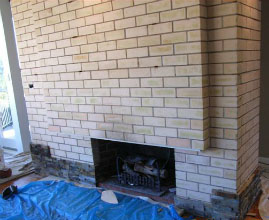Install Stone Veneer Over That Brick!
 The common brick has been an essential building unit for as long as any living person can remember and played an important part in architecture post the Industrial Revolution of the 19th century when bricks were first able to be made at a low cost. For structural and economic reasons, the common brick has been heavily used in the public, government and private sectors alike. And while it would be preposterous to consider changing the brick facades of historical buildings that have stood the test of time, many people, with a particular focus on residential applications, may now consider brick in certain applications to be aged, dull looking and crying out for change.
The common brick has been an essential building unit for as long as any living person can remember and played an important part in architecture post the Industrial Revolution of the 19th century when bricks were first able to be made at a low cost. For structural and economic reasons, the common brick has been heavily used in the public, government and private sectors alike. And while it would be preposterous to consider changing the brick facades of historical buildings that have stood the test of time, many people, with a particular focus on residential applications, may now consider brick in certain applications to be aged, dull looking and crying out for change.
 A great example of the tired worn out brick look starts with the post war construction boom of the 1950s and 1960s where brick was used extensively in residential building applications, in particular the fireplaces of this era’s homes. As the decades rolled by, subsequent homeowners might have painted the brick or simply left it “as is”, which either way, has left the space blank, boring, and in need of a change. With more modern surface materials we can now cover existing brick in places where a fresh look and design can greatly benefit an aged space where brick is no longer considered aesthetically pleasing, all while leveraging the structural integrity of the existing brick. One economical and popular way to go about this task is to use natural stone veneer over the brick. It’s a fun, simple way to update the surface because stone veneers are offered in so many different colors and it’s also a great way to introduce fresh looks and textures into the space. Natural stone was historically sourced as loose individual stones, but with the advent of new quarrying and fabrication techniques, new products have emerged into the natural stone market including panel systems and even pre cut large format natural stone tile such as Norstone’s PLANC product that open up the design possibilities for a variety of projects. In many ways natural stone represents the exact opposite of the brick that it is covering up – the brick being something man made and designed to all look the same, while natural stone is inherently unique and every single piece on the wall is different. Natural stone is organically unique, distinctly made from nature, and is something that just can’t be duplicated in a brick or faux stone material.
A great example of the tired worn out brick look starts with the post war construction boom of the 1950s and 1960s where brick was used extensively in residential building applications, in particular the fireplaces of this era’s homes. As the decades rolled by, subsequent homeowners might have painted the brick or simply left it “as is”, which either way, has left the space blank, boring, and in need of a change. With more modern surface materials we can now cover existing brick in places where a fresh look and design can greatly benefit an aged space where brick is no longer considered aesthetically pleasing, all while leveraging the structural integrity of the existing brick. One economical and popular way to go about this task is to use natural stone veneer over the brick. It’s a fun, simple way to update the surface because stone veneers are offered in so many different colors and it’s also a great way to introduce fresh looks and textures into the space. Natural stone was historically sourced as loose individual stones, but with the advent of new quarrying and fabrication techniques, new products have emerged into the natural stone market including panel systems and even pre cut large format natural stone tile such as Norstone’s PLANC product that open up the design possibilities for a variety of projects. In many ways natural stone represents the exact opposite of the brick that it is covering up – the brick being something man made and designed to all look the same, while natural stone is inherently unique and every single piece on the wall is different. Natural stone is organically unique, distinctly made from nature, and is something that just can’t be duplicated in a brick or faux stone material.
If you are considering installing stone veneer over brick, here are some of the key steps and considerations for this type of project:
Evaluate the Existing Brick
To assess the suitability of a brick fireplace substrate for a natural stone veneer overlay, begin by thoroughly inspecting the condition of the existing brick surface. Look for signs of structural integrity, such as cracks, spalling, or loose mortar, as a stable foundation is crucial for a successful stone veneer application. Understand if the fireplace is on an exterior wall or interior load bearing wall and how that might impact adding additional weight to the wall structure. Additionally, ensure the substrate is free from contaminants like dirt or grease, and consider performing a moisture test to prevent potential adhesion issues. One of the biggest roadblocks in a renovating an old brick fireplace is if the brick has been painted. Paint acts as a bondbreaker for the thinset that is used to install the stone veneer with. Ultimately what you are looking to understand with this evaluation step is to understand if the brick can support the added weight of the stone and if the stone can be bonded directly to the brick, or if the brick surface needs to be prepared or covered up to create a suitable substrate for a stone installation. When in doubt, hire a qualified contractor to evaluate the fireplace.
Prepare the Existing Brick into a Cementious Substrate
If the brick wall is structurally sound and free of any contaminants or bond breakers, and its determined that the stone veneer can be installed directly to the existing brick, the most common step is for a masonry skim coat, sometimes referred to as a brown coat, which is a thin layer of mortar that is floated over the surface. This step fills in all the gaps and cracks, and is designed to get you a plumb, level, and appropriately textured surface to start installating stone veneer against.
If it’s determined that there are contaminants, such as painted brick, that will effect the bond between the brick and newly installed stone veneer, the best option we have found is to overlay the existing brick fireplace with either cement board or a more traditional metal lath and scratch coat technique which essentially creates a new substrate for the stone veneer to be installed against. Since this new cementious layer goes right over the existing brick it’s important the correct mechanical fasteners are used to attach the cement board or metal lath to the brick substrate. Norstone recommends using cement board as the overlay as it’s cleaner and easier to work with than a more traditional metal lath and scratch coat technique.
Install the Stone Veneer over Brick
 Like a lot of home improvement projects, doing the proper prep work in preparing the substrate is essential, such that once that is completed, installing the stone veneer onto the fireplace is a relatively simple step. stone veneers, like Norstone’s Rock Panel product, can be installed directly to the cementitious / brick substrate using a tile thinset. Always remember to back butter your veneers with a layer of thinset when installing to ensure 100% adhesion to the substrate. For a complete run down of installation instructions visit our Installation page and download the installation guide for the product series you are working with.
Like a lot of home improvement projects, doing the proper prep work in preparing the substrate is essential, such that once that is completed, installing the stone veneer onto the fireplace is a relatively simple step. stone veneers, like Norstone’s Rock Panel product, can be installed directly to the cementitious / brick substrate using a tile thinset. Always remember to back butter your veneers with a layer of thinset when installing to ensure 100% adhesion to the substrate. For a complete run down of installation instructions visit our Installation page and download the installation guide for the product series you are working with.
After reviewing the guide, you’ll soon realize how quick and simple it is to install our Rock Panels on your fireplace, and you’ll be off to the races.
Enjoy!
Leveraging the rapid installation a panel system provides, most DIY installers can turn an old worn out brick fireplace into the centerpiece of a room in about a weekend. So if you are looking for something that will be easy to install, cost effective, and last for as long as you want it to, consider installing stone veneer over an existing brick substrate and enjoy your refreshed space!
Lastly, for a more detailed look at how to install stacked stone over brick, be sure to consult our comprehensive installation guide, or if you’re just looking for a little inspiration for your own project, then grab a cup of coffee and head on over to our exterior stone veneer siding gallery.
.png)




